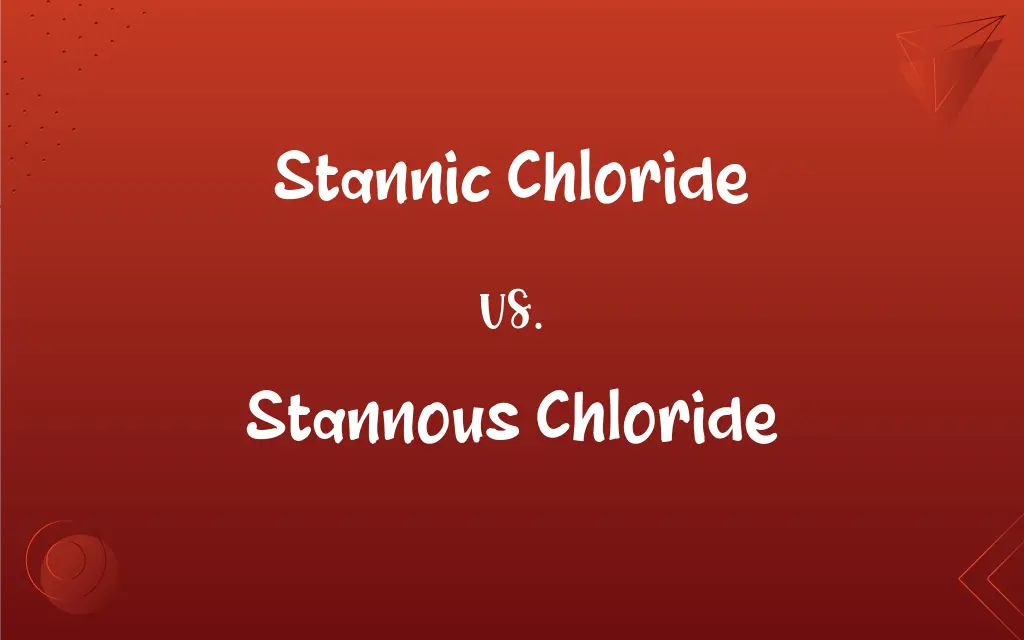Stannic Chloride vs. Stannous Chloride: What's the Difference?
Edited by Aimie Carlson || By Harlon Moss || Published on March 29, 2024
Stannic chloride refers to tin(IV) chloride with the formula SnCl4, while stannous chloride denotes tin(II) chloride, SnCl2, indicating their oxidation states.

Key Differences
Stannic chloride (SnCl4) and stannous chloride (SnCl2) are both compounds of tin and chlorine, but they differ in the oxidation state of the tin. Stannic chloride contains tin in a +4 oxidation state, whereas stannous chloride features tin in a +2 oxidation state. This difference significantly impacts their chemical properties and uses.
In terms of physical properties, stannic chloride is a colorless, fuming liquid with a pungent odor at room temperature, known for its use as a Lewis acid in organic syntheses and as a catalyst in the production of other chemicals. Stannous chloride, on the other hand, appears as a white solid that dissolves in water to give a colorless solution, widely used as a reducing agent in acid solution and in the tin plating of steel.
Chemically, stannic chloride is more stable and less reactive than stannous chloride due to the higher oxidation state of tin. It tends to act as a strong Lewis acid, forming complexes with donor molecules. Stannous chloride is a strong reducing agent, readily oxidized in air to form stannic chloride, highlighting its higher reactivity.
Stannic chloride's applications extend into the production of inorganic tin compounds and as an intermediate in manufacturing organotin compounds. It is also used in glass coating processes. Stannous chloride finds use in the textile industry for dyeing and printing and serves as a mordant in textile dyeing, demonstrating its versatility in industrial applications.
The toxicity and handling precautions for these compounds vary; stannic chloride is corrosive to the skin and mucous membranes, requiring careful handling, while stannous chloride, although less corrosive, still poses risks due to its reducing properties and potential to release hydrogen chloride gas in moist air.
ADVERTISEMENT
Comparison Chart
Oxidation State
+4
+2
Physical State
Colorless, fuming liquid
White solid
Chemical Reactivity
Less reactive, acts as a Lewis acid
More reactive, strong reducing agent
Uses
Lewis acid, glass coatings
Reducing agent, tin plating
Toxicity
Corrosive to skin and mucous membranes
Less corrosive, releases HCl gas in moist air
ADVERTISEMENT
Stannic Chloride and Stannous Chloride Definitions
Stannic Chloride
Handling Precautions.
Due to its corrosive nature, handling stannic chloride requires protective gear.
Stannous Chloride
Chemical Reactivity.
Its reactivity allows stannous chloride to be easily oxidized to stannic chloride in air.
Stannic Chloride
Industrial Use.
It is utilized in the production of organotin compounds and glass coatings.
Stannous Chloride
Oxidation State.
Stannous chloride features tin in a +2 oxidation state, making it a strong reducing agent.
Stannic Chloride
Physical Properties.
As a colorless, fuming liquid, stannic chloride is used in organic syntheses.
Stannous Chloride
Physical Properties.
Appearing as a white solid, stannous chloride is soluble in water, forming a colorless solution.
Stannic Chloride
Oxidation State.
Stannic chloride, with tin in a +4 oxidation state, acts as a strong Lewis acid.
Stannous Chloride
Industrial Use.
Widely used in tin plating and as a mordant in the textile industry.
Stannic Chloride
Chemical Stability.
Stannic chloride is chemically more stable than stannous chloride.
Stannous Chloride
Handling Precautions.
Stannous chloride should be handled carefully to avoid exposure to its reducing effects and potential HCl release.
FAQs
How are these compounds handled safely?
Both require careful handling; stannic chloride needs to be handled with protective gear due to its corrosivity, while stannous chloride requires precautions against its reducing properties and potential to release HCl gas.
Why is stannic chloride used as a Lewis acid?
Its +4 oxidation state allows stannic chloride to accept electrons, making it an effective Lewis acid in chemical reactions.
What distinguishes stannic chloride from stannous chloride?
The main distinction lies in the oxidation state of tin: +4 in stannic chloride and +2 in stannous chloride.
What are the industrial applications of stannous chloride?
It is used for tin plating, reducing agent in chemical syntheses, and as a mordant in textile dyeing.
Can stannous chloride act as an oxidizing agent?
No, stannous chloride acts as a reducing agent due to its +2 oxidation state, readily donating electrons.
Are both compounds soluble in water?
Stannic chloride is less soluble in water, forming a hydrochloric acid solution upon hydrolysis, whereas stannous chloride dissolves well, forming a colorless solution.
Why is protective gear important when handling these chemicals?
To prevent skin and eye irritation, respiratory problems, and other health hazards due to their corrosive and toxic nature.
Can stannous chloride be used in food packaging?
While not directly used in food packaging, its derivatives or the tin-plated materials made using stannous chloride can be involved in food packaging applications with appropriate safety measures.
How does the difference in oxidation states between stannic and stannous chloride influence their environmental fate?
The higher oxidation state of stannic chloride makes it more prone to hydrolysis, affecting water pH, whereas stannous chloride, being a reducing agent, can impact redox balance in aquatic systems, potentially leading to lower dissolved oxygen levels.
Why does stannous chloride oxidize in air?
Its lower oxidation state (+2) makes it prone to oxidation, seeking a more stable electronic configuration.
Can either compound be used in organic synthesis?
Yes, stannic chloride is often used as a catalyst or reagent in organic synthesis due to its Lewis acid properties.
Can stannic chloride be converted to stannous chloride?
Yes, stannic chloride can be reduced to stannous chloride under certain chemical conditions, typically involving a reducing agent.
What is the role of stannic chloride in glass coating?
Stannic chloride is used to apply a thin film on glass, enhancing its appearance and durability.
What safety measures are recommended when working with these chemicals?
Use of protective clothing, gloves, goggles, and working in a well-ventilated area or fume hood are recommended to mitigate risks.
How do stannic and stannous chloride affect human health?
Both compounds can be harmful if ingested, inhaled, or come into contact with skin. Stannic chloride is particularly corrosive, while stannous chloride may cause irritation and toxic effects due to its reducing nature.
What is the significance of the solubility of stannous chloride in water?
Its solubility allows it to be used in various aqueous applications, such as electroplating and as a reducing agent in chemical syntheses and analytical chemistry.
What environmental impacts do these compounds have?
If released into the environment, they can be toxic to aquatic life. Stannic chloride can hydrolyze, contributing to acidity in water bodies, while stannous chloride might reduce dissolved oxygen, affecting aquatic organisms.
What role does stannous chloride play in photography?
Stannous chloride is used as a reducing agent in older photographic processes, helping to develop images on film.
How does the chemical stability of stannic chloride benefit its industrial applications?
Its stability makes it suitable as a catalyst or intermediate in processes that require a stable compound to facilitate reactions without decomposing.
What precautions are necessary for storing stannic and stannous chloride?
They should be stored in tightly sealed containers, away from moisture and oxidizing agents, and in a cool, well-ventilated area to prevent degradation and hazardous reactions.
About Author
Written by
Harlon MossHarlon is a seasoned quality moderator and accomplished content writer for Difference Wiki. An alumnus of the prestigious University of California, he earned his degree in Computer Science. Leveraging his academic background, Harlon brings a meticulous and informed perspective to his work, ensuring content accuracy and excellence.
Edited by
Aimie CarlsonAimie Carlson, holding a master's degree in English literature, is a fervent English language enthusiast. She lends her writing talents to Difference Wiki, a prominent website that specializes in comparisons, offering readers insightful analyses that both captivate and inform.
































































